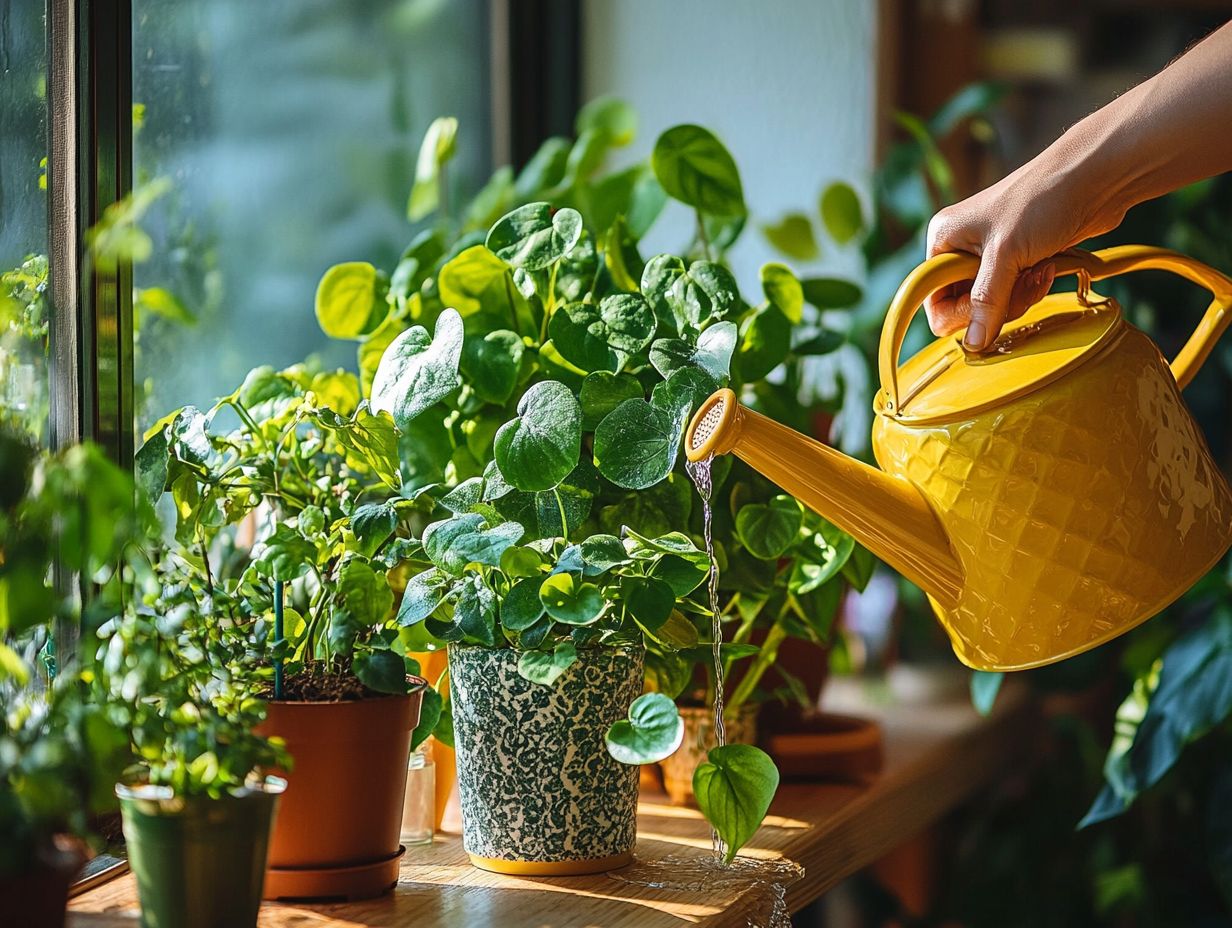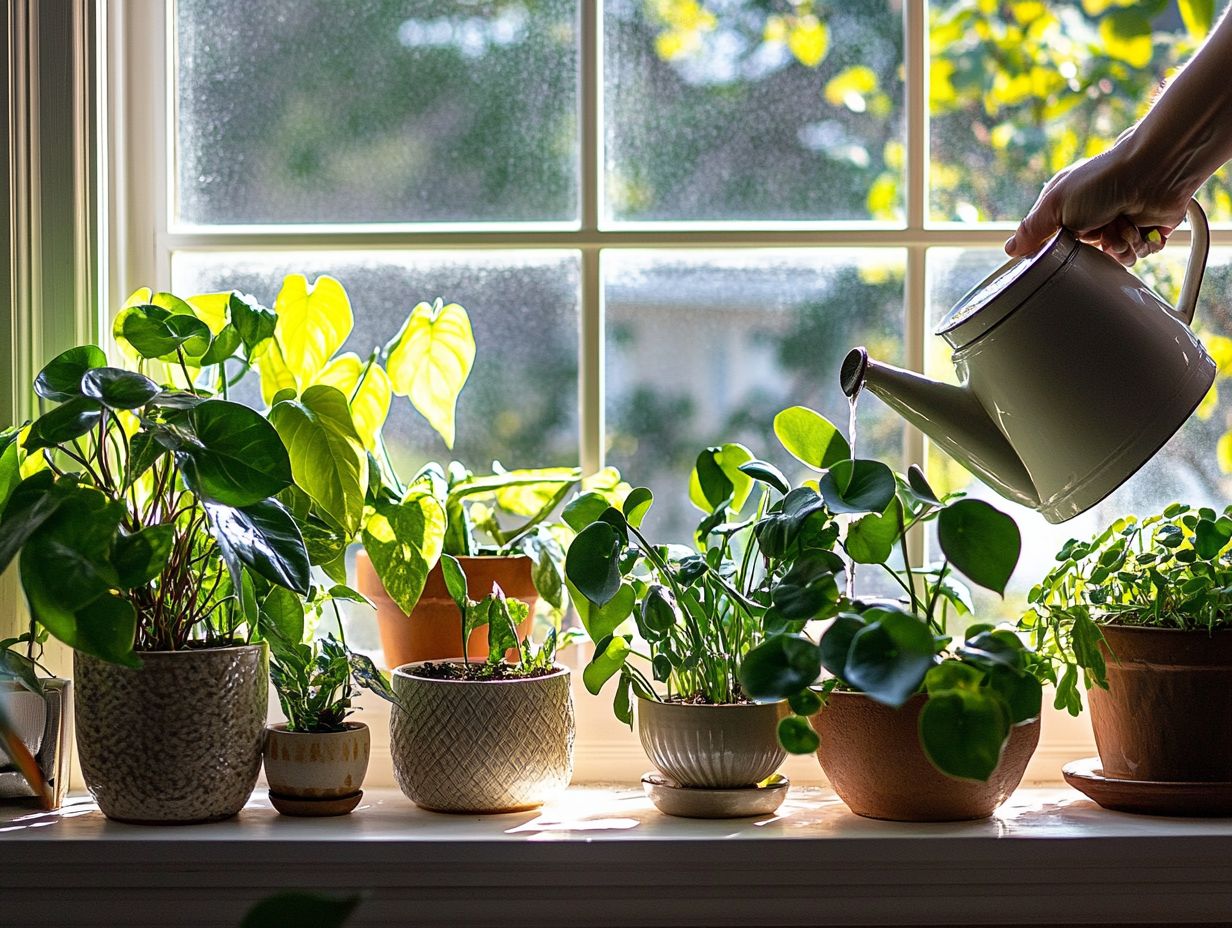Exploring Sustainable Destinations Worldwide
Proper watering is crucial for maintaining the health and vibrancy of your indoor plants. With a variety of species and differing environmental conditions, figuring out how to hydrate them can feel overwhelming. This article explains the important role water plays in plant growth, outlining key factors to consider when watering. You’ll learn techniques tailored for different types of plants, alongside signs of over and under-watering.
It also introduces effective tools for measuring moisture levels in the soil. Explore how to keep your indoor garden flourishing and thriving with the right approach to watering!
Contents
- Key Takeaways:
- Why Proper Watering is Important for Indoor Plants
- Factors to Consider when Watering Indoor Plants
- Watering Techniques for Different Types of Indoor Plants
- Signs of Over and Under-Watering
- Tools and Techniques for Measuring Water Levels
- Common Questions About Indoor Plant Care
- What are the best watering techniques for indoor plants?
- How often should I water my indoor plants?
- Is it better to water indoor plants from the top or bottom?
- Should I use tap water or filtered water for my indoor plants?
- Can I water my indoor plants with ice cubes?
- How can I tell if I am overwatering or underwatering my indoor plants?
Key Takeaways:

- Proper watering is crucial for indoor plants, as water plays an important role in their growth and health.
- Consider factors such as plant species, environment, and watering frequency/amount when determining the best watering technique for your indoor plants.
- Different types of indoor plants require specific watering methods. For example, succulents and cacti need infrequent but deep watering, while tropical plants may require more frequent watering and higher humidity levels.
Why Proper Watering is Important for Indoor Plants
Proper watering is an essential cornerstone of indoor plant care that profoundly influences the health and growth of your houseplants. Grasping the specific watering requirements of various types, such as succulents, philodendrons, and cacti, is crucial for maintaining the right amount of moisture in the soil and avoiding pitfalls like overwatering or wilting leaves.
Factors like climate conditions, light exposure, and humidity levels are important in guiding the appropriate watering frequency and techniques necessary for keeping indoor plants thriving and cultivating a flourishing indoor garden.
The Role of Water in Plant Growth
Water is essential for your plants’ growth, acting as a critical component for transporting nutrients and ensuring the health of their root systems. It enables effective absorption, helping your plants extract vital nutrients from the soil, which directly fuels their growth and vitality.
Maintaining proper air circulation and moisture levels is crucial for creating a thriving growing environment. The type of soil you use, whether sandy or clay, profoundly impacts how water is retained and moves through the ground. This ultimately affects how well roots can access those nutrients.
Well-aerated soils promote water penetration, allowing roots to breathe and absorb the moisture they require without the risk of becoming waterlogged. Adequate drainage and balanced moisture levels are key to preventing root rot while encouraging robust growth.
Clearly, the intricate balance of water availability, soil composition, and air circulation is pivotal for determining your plants’ health and productivity. Understanding these dynamic interactions is essential for any gardener or farmer aiming for success.
Factors to Consider when Watering Indoor Plants
When it comes to watering your indoor plants, several key factors deserve your attention to ensure their optimal health and growth.
Understanding your plants specific watering needs is crucial. This includes the right frequency and amount of water. Additionally, considerations such as pot size, pot material, and the presence of drainage holes can profoundly influence how water is retained or drained, ultimately impacting the overall well-being of your plants.
Drainage holes help excess water escape the pot, preventing soggy roots. Root rot occurs when roots sit in water for too long, causing them to decay.
Ready to see your indoor plants thrive? Start applying these watering techniques today!
Plant Species and Environment
Different plant species have unique watering requirements, influenced by their native climates. For instance, if you’re caring for succulents and cacti, which thrive in arid conditions, they need less frequent watering. In contrast, tropical plants like philodendrons prefer a humid environment, requiring a consistent watering schedule.
This contrast emphasizes how geographic origin plays a crucial role in determining hydration needs. For example, ferns are often found in lush forests and demand higher moisture levels due to their habitats rich in rainfall. The resilient rubber plant, hailing from tropical rainforests, can adapt to occasional droughts but still appreciates regular watering.
Moisture-loving peace lilies thrive in high-humidity environments, making them perfect for spaces like bathrooms or kitchens. Meanwhile, the snake plant is ideal if you tend to forget about your plants; it can survive neglect, making it great for a dry office setting. By understanding these specific preferences, you can provide better care and cultivate healthier plants.
Watering Frequency and Amount

Determining the right watering frequency and amount is essential for maintaining the right amount of water in the soil and fostering healthy plant growth. Using tools to check soil moisture can help you know when to water. This allows you to respond to your plants’ growth cues and adjust your watering schedule according to seasonal changes and specific plant needs.
Observing the moisture content in your soil helps you understand what your plants truly require. This ensures each variety receives the appropriate amount of water. If you notice signs like drooping leaves or stunted growth, it may be time to reevaluate your watering routine.
During the hotter months, you ll need to water more often to keep your plants happy. The cooler seasons may require less. Tools to check soil moisture eliminate the guesswork and guide your decisions. By tailoring your watering schedules, you support robust plant health and conserve water, making your gardening efforts both sustainable and efficient.
Watering Techniques for Different Types of Indoor Plants
Various indoor plants demand distinct watering techniques to thrive, spanning from traditional methods to inventive solutions like self-watering planters. Understanding the specific needs for succulents, tropical plants, and delicate ferns and mosses is crucial for proper hydration and overall vitality.
Mastering these techniques will enhance your gardening skills and help you foster a thriving indoor oasis. For instance, learning specific watering techniques for newly potted plants can make a significant difference.
Watering Methods for Succulents and Cacti
Succulents and cacti, celebrated for their remarkable ability to store water, require specific watering techniques to prevent overwatering. This ensures their thriving existence. To maintain their health, implement effective drainage solutions and use the right soil types to support these plants.
To achieve optimal hydration, embrace the soak-and-dry method. This means thoroughly watering your plant and letting the soil dry out completely before the next watering. For more insights into this technique, check out watering frequency: what your indoor plants want, as it mimics the plants’ natural environment and fosters robust root development.
Choose a well-draining soil mix, typically made of coarse sand or perlite, to minimize moisture retention. Using pots with drainage holes also ensures that excess water escapes, reducing the risk of root rot and other water-related issues.
By combining these watering practices with the right soil conditions, you’ll enhance the resilience and vitality of your succulents and cacti, allowing them to flourish beautifully.
Start now to transform your indoor space into a vibrant oasis!
Watering Techniques for Tropical Plants
Tropical plants flourish in high humidity. You ll need to employ specific watering techniques to effectively replicate their natural environment. Proper light exposure and air circulation, combined with consistent watering practices, are essential for keeping these healthy indoor plants thriving.
To promote optimal growth, keep a close eye on soil moisture. Water only when the top inch of soil feels dry. Consider using methods like misting or placing a humidifier nearby to maintain the elevated humidity levels these plants crave. For detailed insights, check out watering techniques for different indoor species. Ensuring they receive bright, indirect sunlight will enhance their vibrancy while protecting the leaves from scorching.
Incorporating adequate air circulation is important. You might use a fan or rotate the plant to significantly reduce the risk of fungal diseases. With these practices, you ll create a flourishing and stunning indoor garden that truly stands out.
Watering Tips for Ferns and Mosses
Ferns and mosses thrive in moist environments. Giving them the right attention to their watering needs is essential for holding water and encouraging healthy growth. Recognizing ideal humidity levels and employing effective watering strategies will greatly enhance their vitality and overall well-being.
To create the perfect environment, aim for humidity levels between 40% and 70%. Regular misting is an excellent way to boost air moisture, especially if you’re cultivating them in drier climates. Ensure your ferns are planted in well-draining soil and incorporate organic matter, such as peat moss, to retain necessary moisture without risking waterlogging. Allow the top inch of soil to dry out between waterings. Overwatering can lead to root rot.
Consider using a humidity tray filled with water and pebbles to further sustain the moist conditions these plants desire.
Signs of Over and Under-Watering

Spotting the signs of over or under-watering is crucial for thriving plants!
Symptoms like wilting leaves, stunted growth, and fungal infections signal that something’s wrong with your watering routine. Take immediate corrective action.
How to Identify and Correct Watering Issues
Identifying and correcting watering issues is essential for maintaining the health and longevity of your indoor plants. By observing the symptoms of both overwatering and under-watering, you can take proactive steps to restore balance and encourage vibrant growth.
Start by assessing soil moisture. Stick your finger about an inch into the soil; if it feels dry, it’s time to give your plant a drink. If the texture is soggy, your plant might be drowning. For more detailed guidance, check out our watering techniques for ferns.
Look out for signs like yellowing leaves or wilting. These can signal distress linked to moisture levels. If you suspect overwatering, allow the soil to dry out between waterings and opt for a well-draining pot. For more effective techniques, consider these watering strategies for large indoor plants. Don’t wait until it’s too late—act now to keep your plants healthy!
If under-watering is the issue, establish a consistent watering schedule, as indoor plants tend to flourish with regular care. Utilizing moisture meters can also provide you with precise readings, helping you sidestep the top 7 mistakes in watering indoor plants common pitfalls of plant care.
Tools and Techniques for Measuring Water Levels
Employing the right tools and techniques to measure water levels can significantly elevate your indoor plant care game. Devices like moisture meters allow you to accurately gauge soil moisture, tailoring your watering practices to meet the unique needs of each houseplant.
This approach not only optimizes your watering routine but also enhances drainage solutions for healthier, thriving plants.
Always check your plants regularly to catch any issues early. Take these tips to heart and watch your plants thrive like never before!
Using Moisture Meters and Other Tools
Moisture meters are invaluable tools that offer precise readings of soil moisture levels, enabling you to fine-tune your watering practices with confidence. By interpreting the data these devices provide, you can respond to your plants’ signals and maintain their health through the right watering frequency.
Understanding how these meters function can greatly elevate your indoor gardening experience. Essentially, they measure the soil’s ability to conduct electricity, which directly relates to moisture content. A quick glance at the meter can instantly inform you if it s time to water, minimizing the risks of both overwatering and underwatering.
For optimal results, it’s crucial to take readings multiple times a week and from various areas of the pot. When you check the meter, a low moisture level typically signals that it’s time for watering. Higher readings indicate that the soil is adequately moist. Incorporating this practice into your routine care will allow you to nurture your indoor greenery more effectively, as you learn more about the science of watering indoor plants, ensuring your plants thrive.
Common Questions About Indoor Plant Care
What are the best watering techniques for indoor plants?

The best watering techniques for indoor plants depend on the type of plant, its environment, and its specific needs. Generally, water indoor plants when the top inch of soil is dry and water deeply until water drains from the bottom.
How often should I water my indoor plants?
The frequency of watering varies depending on the type of plant, the humidity in the environment, and the size of the pot. In general, it is recommended to water once or twice a week, but always check the soil moisture level before watering.
Is it better to water indoor plants from the top or bottom?
It is generally better to water from the top, as this mimics natural rainfall and ensures that all parts of the plant receive moisture. However, bottom watering can be effective for certain types of plants, such as succulents, as it prevents water from sitting on the leaves and causing damage.
Should I use tap water or filtered water for my indoor plants?
Using filtered water is best for indoor plants, as tap water often contains chemicals like chlorine and fluoride that can be harmful. If filtered water is not available, you can use tap water that has been left out for 24 hours to allow the chemicals to dissipate.
Can I water my indoor plants with ice cubes?
While it may seem convenient to water with ice cubes, this method can actually be harmful to plants. The sudden temperature change can shock the roots and cause damage, and the slow melting of ice may not provide enough water.
How can I tell if I am overwatering or underwatering my indoor plants?
Overwatering and underwatering can both negatively affect indoor plants. Signs of overwatering include:
- Yellowing leaves
- Wilting
- Mold or fungus growth
Signs of underwatering include:
- Dry, crispy leaves
- Drooping
Finding a balance and adjusting watering frequency is important based on the condition of your plants.





